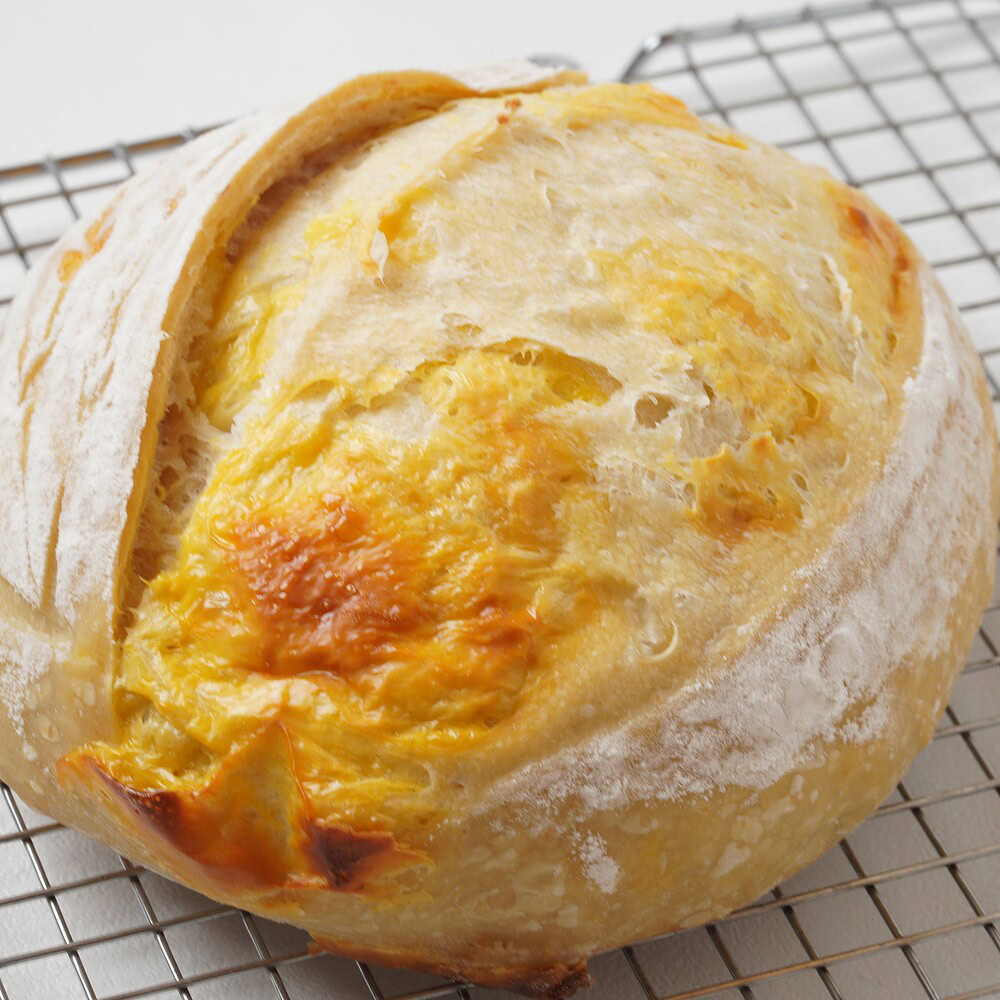Published on 14th August 2019
Makes 1 large loaf or 2 small
Credit: Vanessa Kimbell of The Sourdough School | https://www.sourdough.co.uk/
To get ready for Sourdough September, we present Vanessa’s step-by-step guide to making a sourdough loaf. Whilst it may seem daunting it isn’t complicated – and the results should be worth it!
Vanessa has a special interest in the gut microbiome and is currently studying towards a PhD in Nutrition and Digestibility of Bread.
Vanessa says: “This is a recipe that fits with everyday life. I use timings and temperatures to suit a 9-5:30pm working day. You refresh your starter before you go to work and bake to a convenient schedule. When sourdough is this easy you are much more likely to bake. It is also the kind of sourdough bread that you can make in no time.
“I often describe this technique as fridge raid bread. Although I have suggested using cheese, onions and sage, you could use up whatever you have left in the fridge to make this loaf. Sundried tomatoes are delicious, as are feta and olives.
“The onions have inulin in, which is a good prebiotic; however if you suffer with IBS [irritable bowel syndrome] then remove the onions before eating. That way you get flavour but not the negative effect on your digestive system.
“It is also a bread that keeps longer because of the oil, and because it is in a tin you can ferment it longer if you need further reduction of the of gluten load.”
Ingredients:
- 340 g water, at a temperature of about 23C. (Note, water is measured by weight rather than volume.)
- 100 g sourdough starter (5 hours old)
- 200 g of stoneground organic spelt flour
- 300 g organic strong white flour
- 10 g fine sea salt
- 1 small red onion, cut into rings
- 2-3 spring onions, cut in half longways
- 45-50 g cheese
- Butter to grease the tin
- A small handful of cherry tomatoes (optional)
- 3-4 spring of fresh sage
- Enough oil to drizzle about 2 tablespoons of olive oil over the top and around the sides of the loaf.
Equipment:
- A large mixing bowl
- A large loaf tin or 2 small ones
- 2 clean tea towels
- Wooden spoon
- A sheet of grease proof paper
- A thermometer to check water temperature
Time and temperature guidelines:
|
Refresh starter
|
Friday
|
8am use cold tap water about 16C
|
|
Refresh starter
|
Friday
|
6pm use warmer water, 28C
|
|
Prep & weigh out the ingredients
|
Friday
|
8pm
|
|
Mix Dough
|
Friday
|
9:45pm Dough temperature, 23C.
Leave the tin on the side overnight in the kitchen
|
|
Put your starter back in the fridge
|
Friday
|
10pm Fridge temperature, 5C
|
|
Bake
|
Saturday
|
8am Onwards until 4pm
|
Method:
- Mix | It is important to build the microbes in the starter if you only bake once a week. So, a double refreshment as outlined in the timetable above will make a beautiful loaf. In a large bowl, mix your water and starter and mix well. Getting plenty of oxygen in at this point helps the yeast to reproduce. Pay attention to the temperature of the water and add all the flour and salt and mix until all the ingredients come together. You don’t need to knead but add the last 40 g of water in incrementally over 5-10 mins. Prepare the tin by greasing a sheet of baking parchment lightly with butter, coconut oil or lard (not olive oil) then line the tin with baking parchment. Put a few bits of herbs and onion on the bottom on the pan. Place the dough into the tin. Drizzle with a little olive oil and gently push the cheese, onions, tomatoes and herbs (if using) down the sides of the loaf.
- Prove | Leave your dough overnight covered. Our school is about 23C generally. In the morning it will be 50 per cent bigger. (You can get your loaf sourer, and so more digestible, if needed, by transferring to the fridge for 3-4 hours longer.)
- Bake | In the morning, preheat your oven to 220C for at least 30 mins before you are ready to bake, and place a small pan of boiling water on the shelf underneath (or use a Dutch oven). The hydration helps form a beautiful crust. Turn the heat down to 180C and bake for about 45-50 mins. (Vanessa says: “I don’t give precise timings as everyone’s oven is different but check that your loaf is a beautiful golden colour. Bake to the point that you like it.”)
- Storage | This sourdough is best left to cool in the tin for a few mins before allowing to cool completely on a wire rack, and slicing. (It is even better if left for a day to let the full flavour develop.) Once your sourdough has cooled, store in a linen or cotton bread bag, or wrapped in a clean tea towel.
Newsletter giveaway!
Complimentary Sourdough Club all-access passes for ION newsletter subscribers
This September Vanessa Kimbell, baker, sourdough specialist, award-winning author of the best-selling book The Sourdough School is launching The Sourdough Club. The Sourdough Club is the online source for sourdough with video masterclasses, recipes, tips and tuition all in one place. The videos are hosted by Vanessa, who is supported by a team of expert nutritionists, GPs, microbiologists, psychiatrists, wheat breeders and speciality bakers.
Vanessa would like to offer 25 complimentary memberships to our newsletter readers, on a first come, first served basis. She’d love you to join the club and her journey to share sourdough with the world, one loaf at a time. You’ll get an all-access pass to The Sourdough Club, worth £199, and with that a world of insight into sourdough, nutrition and digestibility of bread.
All you need to do is email clubfriends@sourdough.co.uk with your name, quoting #ION
Winners will be announced on 3 September 2019
Tips on how to refresh and maintain a wholemeal starter
A wholegrain starter is thicker and livelier because it has lots of nutrients and enzymes in it. This refreshment technique is designed to allow you to go to work and come home, so we use water temperature to control the rate of fermentation for a wholegrain starter. By slowing down or speeding up the water temperature you can use the starter to make bread that is optimally fermented.
- 1st refreshment: In the morning it needs to have a lower water temperature because you are leaving it all day. So use cold tap water at about 16C. This will mean the starter will be ready to use and at the peak about 8-9 h later.
- 2nd refreshment: Needs to be warmer (28C) so that the starter is young and lively and ready in about 4-5 h which is in good time for you to use to mix the dough and go to bed on time!
How to refresh
To refresh your starter, mix 25 g of starter with 100 g of water with the flour, mix well and leave, covered on the side in the kitchen. It is ready when it is lively and bubbly.
More advanced recipes and tips are available to members of the sourdough club, and a very in depth explanation is covered on our sourdough courses.
Read more articles and recipes




